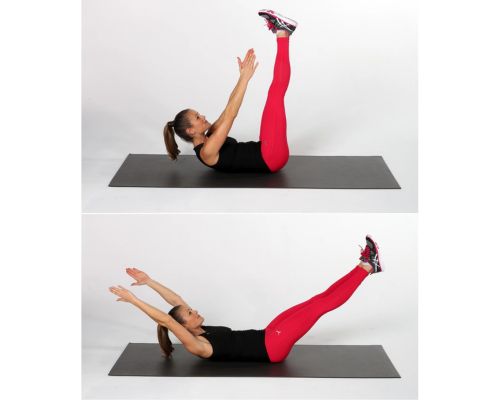


Step into the world of V crunches, where sculpting a strong core feels like a thrilling adventure. With each rep, you’re not just exercising; you’re unleashing your inner core warrior, ready to conquer fitness goals and redefine your strength. So, let’s embrace the burn and soar to new heights of abdominal prowess together!
Key Takeaways
- V crunches effectively target multiple core muscle groups, including the rectus abdominis, obliques, and hip flexors, for a thorough abdominal workout.
- Engaging in V crunches helps improve core stability, which is crucial for maintaining proper posture, balance, and spine alignment.
- Maintain proper form and engage your core during V crunches to maximize benefits and avoid injuries.
- V-crunches offer flexibility, functional strength, and calorie burn beyond just toning abs.
- V crunches add variety and challenge to a fitness routine, preventing plateau and strengthening the core.
What Muscles Does V Crunches Work?
V Crunches primarily target the abdominal muscles, particularly the rectus abdominis. This muscle, running vertically along the abdomen, is responsible for flexing the spine, allowing you to curl your head, shoulders, and torso towards your knees during the V Crunch movement.
Additionally, V Crunches engage the obliques, which are located on the sides of the abdomen. These muscles assist in rotating and bending the torso, providing stability and assisting in the twisting motion often involved in V Crunches.
Furthermore, V Crunches involve the hip flexors, which are a group of muscles that allow you to lift your legs straight towards your chest. By targeting these muscle groups simultaneously, V Crunches can effectively strengthen and tone the core, improve posture, and enhance overall core stability.
How To Perform V Crunches

To perform a V Crunch, you should follow the steps below:
- Lie flat on your back on a mat with your legs extended and arms stretched out above your head. Reach your arms straight forward or reach up toward your shins as you are able.
- Engage your core muscles to lift your legs and upper body off the floor simultaneously, forming a “V” shape with your body.
- As you lift your legs and torso, reach your hands towards your feet, aiming to touch or come as close as possible.
- Hold the contracted position for a moment, focusing on squeezing your abdominal muscles.
- Slowly lower your legs and upper body back down to the starting position with control.
- Repeat the movement for the desired number of repetitions.
Remember these key points:
- Keep your core engaged throughout the exercise to protect your lower back.
- Exhale as you crunch up and inhale as you lower back down.
- Focus on using your abdominal muscles to lift your body rather than relying solely on momentum.
- Avoid straining your neck by keeping it relaxed and in line with your spine.
Benefits of Performing V Crunches
Performing V crunches offers several benefits for your core strength and overall fitness:
Targeted Abdominal Muscle Engagement: V crunches primarily target the rectus abdominis, obliques, and hip flexors, helping to strengthen and tone these muscle groups for a well-defined core.
Improved Core Stability: By engaging multiple abdominal muscles simultaneously, V crunches help enhance core stability, which is essential for maintaining proper posture, balance from right to left leg, and spine alignment.
Enhanced Functional Strength: A strong, core region is crucial for performing daily activities, movement, sports, and other exercises with better efficiency and reduced risk of injury. V crunches contribute to your core region by developing functional strength in your core muscles.
Increased Flexibility: The V crunch movement exercise involves flexing the spine and engaging the hip flexors, promoting flexibility in the abdominal area strong spine, and lower back, which can help prevent stiffness and improve the range of motion.
Calorie Burning and Fat Loss: V crunches, like other core exercises, can contribute to the burning of calories and reduction of body fat, especially when combined with a balanced diet and regular cardiovascular exercise routine.
Incorporating V crunches into your fitness regimen, along with a balanced diet and overall exercise routine, can help you develop a stronger core, improve your posture, and enhance your overall physical fitness level.
Other Variations
If you are looking to train your abdominal muscles, you don’t have to just do v crunches to do so. In fact, there are many other variations of crunches that you can try.
JustFit App also provides easy and effective abs workout routine that you may try doing, from the comforts of your own home. So, what are you waiting for? Try out our JustFit App today!
Conclusion
In conclusion, if you are looking to sculpt and tone the core muscles, you should try V crunches. Doing so brings about several benefits and best of all? You stand to improve your health!
Even if you can only do a few reps, it is perfectly okay. Everyone has to start somewhere and every little step counts!
What are V crunches good for?
Do V crunches work your abs?
How to do V ups properly?
Elizabeth Quinn, MS. (2021). How to Do a V-Sit: Proper Form, Variations, and Common Mistakes. Available at: https://www.verywellfit.com/v-sit-ab-exercise-3120059#:~:text=The%20V%2Dsit%20ab%20exercise,body%20forming%20a%20V%20shape [Accessed 28 Mar 2024].
Alice Twu. (2022). How to Do V-Ups. Available at: https://www.webmd.com/fitness-exercise/how-to-do-v-ups [Accessed 28 Mar 2024].





